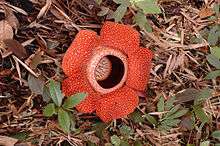Rafflesia
Rafflesia is a genus of parasitic flowering plants in the family Rafflesiaceae. It contains approximately 28 species (including four incompletely characterized species as recognized by Willem Meijer in 1997), all found in Southeast Asia, mainly in Indonesia, Malaysia, Thailand and the Philippines. It was first discovered by French surgeon and naturalist Louis Deschamps in Java between 1791 and 1794, but his notes and illustrations, seized by the British in 1803, were not available to western science until 1861. It was later found in the Indonesian rainforest in Bengkulu, Sumatra by an Indonesian guide working for Joseph Arnold in 1818, and named after Sir Stamford Raffles, the leader of the expedition.
| Rafflesia | |
|---|---|
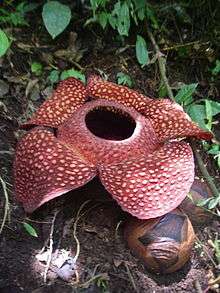 | |
| Rafflesia arnoldii flower and buds, captured in Bengkulu - Indonesia | |
| Scientific classification | |
| Kingdom: | Plantae |
| Clade: | Tracheophytes |
| Clade: | Angiosperms |
| Clade: | Eudicots |
| Clade: | Rosids |
| Order: | Malpighiales |
| Family: | Rafflesiaceae |
| Genus: | Rafflesia R.Br. |
| Type species | |
| Rafflesia arnoldii | |
| Species | |
|
See Classification section | |
Description
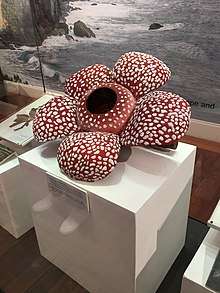
The plant has no stems, leaves or roots. It is a holoparasite of vines in the genus Tetrastigma (Vitaceae), spreading its absorptive organ, the haustorium, inside the tissue of the vine.[1] The only part of the plant that can be seen outside the host vine is the five-petalled flower. In some species, such as Rafflesia arnoldii, the flower may be over 100 centimetres (40 in) in diameter, and weigh up to 10 kilograms (22 lb). A Rafflesia that flowered in West Sumatra in 2019 was measured to be almost 4 feet (120 cm) in diameter, the largest flower ever recorded – 4 inches (10 cm) wider than the flower reported as the largest in 2017.[2] Even one of the smallest species, R. baletei, has 12 cm (5 in) diameter flowers.
The flowers look and smell like rotting flesh, hence its local names which translate to "corpse flower" or "meat flower" (see below). The foul odor attracts insects such as flies, which transport pollen from male to female flowers. Most species have separate male and female flowers, but a few have hermaphroditic flowers. Little is known about seed dispersal. However, tree shrews and other forest mammals eat the fruits and disperse the seeds.
Rafflesia is the official state flower of Indonesia, where it is known as puspa langka (rare flower) or padma paksasa (giant flower), of Sabah state in Malaysia, and of Surat Thani Province in Thailand. In Thailand, Rafflesia can be observed in Khao Sok National Park where the flowers are numbered and monitored by the park rangers.[3]
Rafflesia are also remarkable for showing a large horizontal transfer of genes from their host plants. This is well known among bacteria, but not higher organisms.[1]
Name
The name "corpse flower" applied to Rafflesia can be confusing because this common name also refers to the titan arum (Amorphophallus titanum) of the family Araceae.[1] Moreover, because Amorphophallus has the world's largest unbranched inflorescence, it is sometimes mistakenly credited as having the world's largest flower. Both Rafflesia and Amorphophallus are flowering plants, but they are only distantly related. Rafflesia arnoldii has the largest single flower of any flowering plant, at least in terms of weight. Amorphophallus titanum has the largest unbranched inflorescence, while the talipot palm (Corypha umbraculifera) forms the largest branched inflorescence, containing thousands of flowers; the talipot is monocarpic, meaning the individual plants die after flowering. The flower is sometimes called the "monster flower" for its parasitic tendencies and foul odor.[2]
Classification
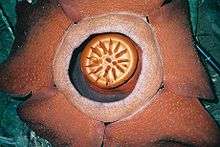
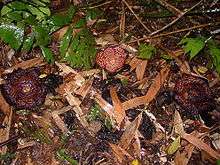
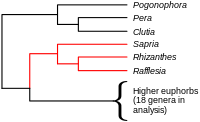
Comparison of mitochondrial DNA (mtDNA) sequences of Rafflesia with other angiosperm mtDNA indicated this parasite evolved from photosynthetic plants of the order Malpighiales.[4] Another study from that same year confirmed this result using both mtDNA and nuclear DNA sequences, and showed the three other groups traditionally classified in Rafflesiaceae were unrelated.[5] A more recent study more specifically found Rafflesia and its relatives to be embedded within the family Euphorbiaceae, which is surprising, as members of that family typically have very small flowers.[6] According to their analysis, the rate of flower size evolution was more or less constant throughout the family except at the origin of Rafflesiaceae, where the flowers rapidly evolved to become much larger before reverting to the slower rate of change.
Verified species
- Rafflesia arnoldii – Sumatra, Borneo
- Rafflesia aurantia – Philippines (Luzon)
- Rafflesia azlanii – Peninsular Malaysia
- Rafflesia baletei – Philippines (Luzon)
- Rafflesia bengkuluensis – Sumatra
- Rafflesia cantleyi – Peninsular Malaysia
- Rafflesia consueloae – Philippines (Luzon)
- Rafflesia gadutensis – Sumatra
- Rafflesia hasseltii – Sumatra
- Rafflesia keithii – Borneo
- Rafflesia kerrii – Thailand, Peninsular Malaysia
- Rafflesia lagascae – Philippines (Luzon)
- Rafflesia lawangensis – Sumatra
- Rafflesia leonardi – Philippines (Luzon)
- Rafflesia lobata – Philippines (Panay)
- Rafflesia manillana – Philippines (Samar)
- Rafflesia micropylora – Sumatra
- Rafflesia mira – Philippines (Mindanao)
- Rafflesia mixta – Philippines (Mindanao)
- Rafflesia patma – Java
- Rafflesia philippensis – Philippines (Luzon)
- Rafflesia pricei – Borneo
- Rafflesia rochussenii – Java, Sumatra
- Rafflesia schadenbergiana – Philippines (Mindanao)
- Rafflesia speciosa – Philippines (Panay)
- Rafflesia tengku-adlinii – Borneo (Sabah)
- Rafflesia tuan-mudae – Borneo (Sarawak)
- Rafflesia verrucosa – Philippines (Mindanao)
Unverified species
- Rafflesia borneensis
- Rafflesia ciliata
- Rafflesia titan
- Rafflesia witkampii
Bornean species
Species native to Borneo include Rafflesia arnoldii, Rafflesia cantleyi, Rafflesia hasseltii, Rafflesia keithii, Rafflesia kerrii, Rafflesia pricei, and Rafflesia tengku-adlinii. R. arnoldii boasts the world's largest single bloom.[7] Some endemic Borneon species, such as R. keithii, begin blooming at night and start to decompose only two to three days later. The time from bud emergence to flowering is six to nine months. Male and female flowers must be open simultaneously for pollination to occur, hence successful pollination and fruit production are quite rare. In addition to habitat loss, these reproductive limitations are contributing factors to why many species are endangered. R. keithii is found along the eastern slopes of Mount Kinabalu in the Lohan Valley of Sabah. Rafflesia tuan-mudae is endemic to only Gunung Gading National Park in Sarawak.
Mindanao (Philippines) species
The Mindanao species is known as Rafflesia schadenbergiana, after the naturalist Alexander Schadenberg, who first discovered the species at the foothills of Mount Apo in 1882. With a flower of nearly a meter, it is close to the size of a 7 year old child when seated. On Mindanao, the species has been seen in Davao del Sur, South Cotabato and Mount Kitanglad in Bukidnon.[8] Second, Rafflesia mira and Rafflesia magnifica are two names for a single species. Both were discovered at Mount Candalaga in Maragusan, Compostela Valley. The two forms differ in size measurements in which the scientific description of Magnifica came from measurements of flowers in full bloom while that of Mira was from photographs of nearly dead samples. The medium-sized Mira and Magnifica flowers measure about half a meter and they have round or elliptic perigone wart.[9] The third species on Mindanao is the Rafflesia mixta which is found so far only in the town of Mainit, Surigao del Norte. It shows a combination of three features of Philippine Rafflesia, namely: the shape and size of the conical process in Rafflesia schadenbergiana, the floral size and sparsely distributed perigone warts of R. speciosa, and the overall resemblance, floral size, faint scent, diaphragm and ramenta morphology of R. mira.[10] Fourth, is Rafflesia verrucosa which is found only in Mount Kampalili in Davao Oriental Province.[11]
Loss of the chloroplast genome
Research published in the journal Molecular Biology and Evolution revealed that one Philippine Rafflesia species from the island of Luzon, Rafflesia lagascae (formerly described as R. manillana), has lost the genome of its chloroplast and it is speculated that the loss happened due to the parasitic lifestyle of the plant.[12]
See also
- Amorphophallus titanum, a similar smelling plant, sometimes also known as the "corpse flower"
- Parasitic plant
- Carrion plant
References
- Shaw, Jonathan (March–April 2017). "Colossal Blossom: Pursuing the peculiar genetics of a parasitic plant". Harvard Magazine. Retrieved 27 June 2017.
- Scottie Andrew. "Scientists just found one of the world's largest flowers blooming in an Indonesian jungle". CNN. Retrieved 5 January 2020.
- "Where to see Rafflesia in Thailand – the biggest flower in the world". 203 Challenges.
- Barkman, T. J.; S.-H. Lim; K. Mat Salleh; J. Nais (January 20, 2004). "Mitochondrial DNA sequences reveal the photosynthetic relatives of Rafflesia, the world's largest flower". PNAS. 101 (3): 787–792. doi:10.1073/pnas.0305562101. PMC 321759. PMID 14715901.
- Nickrent, D. L.; A. Blarer; Y.-L. Qiu; R. Vidal-Russell; F. E. Anderson (October 20, 2004). "Phylogenetic inference in Rafflesiales: the influence of rate heterogeneity and horizontal gene transfer". BMC Evolutionary Biology. 4: 40. doi:10.1186/1471-2148-4-40. PMC 528834. PMID 15496229.
- Davis, C. C.; M. Latvis; D. L. Nickrent; K. J. Wurdack; D. A. Baum (January 11, 2007). "Floral gigantism in Rafflesiaceae". Science. 315 (5820): 1812. doi:10.1126/science.1135260. PMID 17218493.
- "Rafflesia Facts - Rafflesia, The World's Largest Bloom". RafflesiaFlower.com. Retrieved 14 September 2016.
- Barcelona, J.F., P.B. Pelser, A.M. Tagtag, R.G. Dahonog & A.P. Lilangan. 2008. The rediscovery of Rafflesia schadenbergiana Göpp. ex Hieron. (Rafflesiaceae). Flora Malesiana Bulletin 14: 162-165.
- Madulid, D.A.; Tandang, D.N. & Agoo, E.M.G. (2008). "Rafflesia magnifica". IUCN Red List of Threatened Species. Version 2013.2. International Union for Conservation of Nature. Retrieved 22 November 2013.
- M.E. Manting, R.B. Arbolonio, R.B. Caballero & P.B. Pelser. 2014. Rafflesia mixta (Rafflesiaceae), a new species from Surigao del Norte, Mindanao, Philippines
- Balete, D.S., P.B. Pelser, D.L. Nickrent & J.F. Barcelona. 2010. Rafflesia verrucosa (Rafflesiaceae), a new species of small-flowered Rafflesia from eastern Mindanao, Philippines. Phytotaxa 10: 49-57.
- Molina, Jeanmaire; Hazzouri, Khaled M.; Nickrent, Daniel; Geisler, Matthew; Meyer, Rachel S.; et al. (2014). "Possible Loss of the Chloroplast Genome in the Parasitic Flowering Plant Rafflesia lagascae (Rafflesiaceae)". Molecular Biology and Evolution. 31 (4): 793–803. doi:10.1093/molbev/msu051. PMC 3969568. PMID 24458431.
Further reading
- Jamili Nais (2001). Rafflesia of the world. Kota Kinabalu: Sabah Parks. ISBN 978-983-812-042-5. OCLC 50043098.
External links
| Wikimedia Commons has media related to Rafflesia. |
